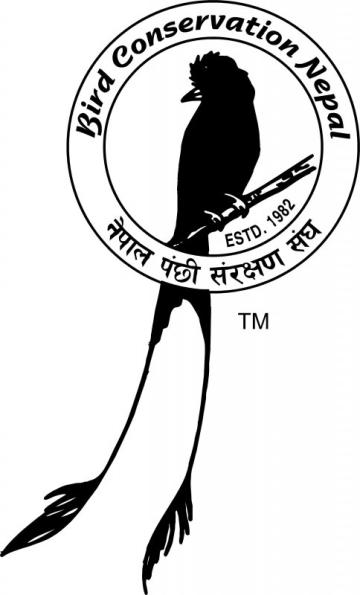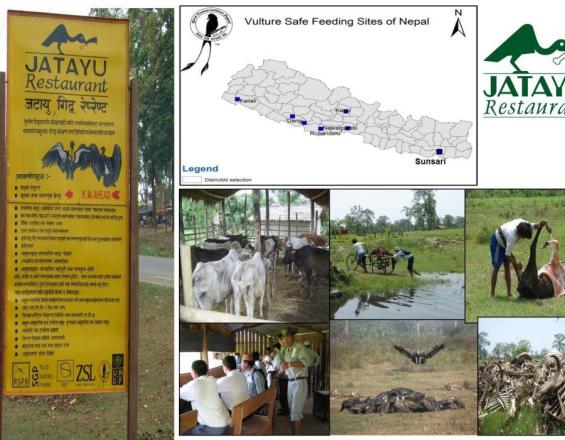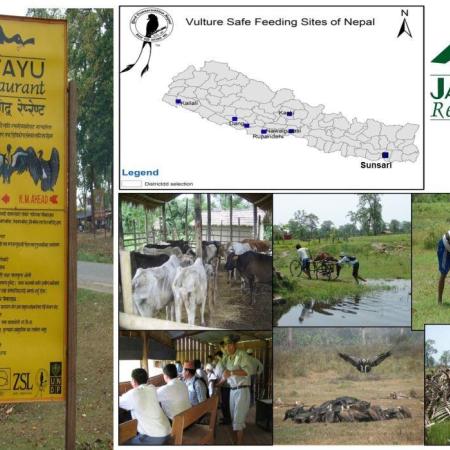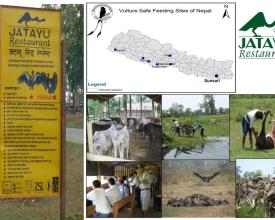
Le retour du vautour : des zones de sécurité pour les vautours gérées par la communauté au Népal

Les vautours Gyps ont failli disparaître en Asie du Sud à la fin des années 1990 à la suite d'un empoisonnement généralisé par le diclofénac. La disparition des vautours a entraîné la perte du service écosystémique qu'ils fournissaient, à savoir l'élimination efficace et sûre des carcasses. Les vautours sont plus compétitifs que les autres charognards, mais leur nombre est désormais si faible qu'ils ont été remplacés par des charognards nettement moins efficaces et moins sûrs, tels que les chiens, les rats, etc. Cette situation a considérablement augmenté le risque de maladie, en particulier de rage, ainsi que le risque de contamination de l'eau. Pour préserver ces vautours, BCN a mis en place des sites d'alimentation sans danger pour les vautours (VSFS) dans la zone tampon du parc national de Chitwan au Népal. Il s'agit d'initiatives communautaires qui s'occupent du bétail âgé et indésirable jusqu'à sa mort naturelle, sans utiliser d'AINS toxiques pour les vautours. Les habitants bénéficient de revenus directs et indirects (vente de lait, de peaux, d'os et de fumier ou création de micro-entreprises).
Contexte
Défis à relever
Le vautour n'étant pas une créature socialement acceptée au sein de la communauté hindoue comme au Népal, il n'a pas été facile de sensibiliser les communautés locales à son importance et à la nécessité de s'engager dans sa conservation. C'est pourquoi le VSFS a été baptisé "Jatayu restaurant" en népalais, Jatayu étant le vautour qui, dans la mythologie hindoue, a sauvé la déesse Sita. Le travail magique de Jatayu et le soutien du naturaliste local Dhan Bahadur Choudhary ont joué un rôle déterminant dans l'engagement des communautés locales dans le programme de conservation des vautours.
Notre programme de rétablissement des vautours a utilisé une combinaison de science, de plaidoyer et d'engagement communautaire pour mettre fin à l'utilisation vétérinaire d'AINS toxiques pour les vautours.
Pour réussir à restaurer les populations de vautours, nous nous concentrons sur l'autonomisation des communautés et le développement de modèles durables pour gérer les sites d'alimentation sûrs pour les vautours.
Emplacement
Traiter
Résumé du processus
Dans notre solution, nous avons des personnes très ciblées (scientifiques citoyens) qui ont très clairement vécu le déclin de la population de vautours en danger critique d'extinction et le problème de l'élimination des carcasses. Ce groupe de personnes est chargé de gérer la zone de sécurité pour les vautours gérée par la communauté. En s'appropriant la gestion, ce groupe de personnes a été d'un grand soutien dans la mise en œuvre du programme de conservation des vautours gravement menacés d'extinction. Ils sont désormais reconnus au niveau national et international pour leur travail de pionnier.
Le pouvoir de la connaissance et de l'appropriation a donc très bien fonctionné dans notre solution.
Blocs de construction
La communauté locale en tant que scientifique citoyen
L'un des principaux éléments de cette solution est la science citoyenne, puisque les habitants surveillaient eux-mêmes la colonie de vautours et qu'il leur était donc très facile de comprendre le déclin de la population de vautours. L'élimination des carcasses était également un fardeau pour eux. La science citoyenne est très utile pour mobiliser le groupe afin qu'il prenne des mesures pour résoudre le problème. Les communautés se sont montrées très favorables à la mise en place d'un restaurant de vautours géré par la communauté. Ce restaurant consiste en une étable où les vieilles vaches sont gardées jusqu'à ce qu'elles meurent naturellement, avant d'être données en pâture aux vautours dans un espace ouvert désigné à cet effet. Les vautours qui y nichent peuvent ainsi se nourrir de carcasses sûres, exemptes de diclofénac. En outre, un refuge pour oiseaux et un centre d'information ont été créés pour permettre aux touristes et au grand public de voir les vautours se nourrir et de partager des connaissances sur la crise des vautours dans le pays et sur les efforts de conservation déployés par les communautés locales. Les communautés bénéficient également de la promotion du tourisme.
Facteurs favorables
Un concept d'action locale très simple est le facteur de réussite de cet élément de construction. Les actions sont les mêmes que celles qu'un agriculteur fait dans la vie de tous les jours, mais elles ont réussi à attirer des visiteurs sur le site, ce qui a permis de générer des revenus pour les habitants.
Leçon apprise
L'institutionnalisation du groupe et la bonne gouvernance sont très importantes pour travailler avec la communauté locale à long terme. Un plan à long terme sous une forme documentée sera très utile pour un bon partenariat de travail. Les activités génératrices de revenus doivent toujours être liées à l'implication de la population locale dans le travail de conservation à long terme.
Gestion communautaire de la zone de sécurité pour les vautours
Le succès des zones de sécurité pour les vautours gérées par la communauté est dû au fait que les communautés locales en sont propriétaires. Lorsque les populations locales sont propriétaires, elles se sentent investies de leurs droits et sont encouragées à investir leurs ressources et leur temps. Les habitants peuvent considérer la propriété elle-même comme une récompense et leur volonté de soutenir la cause sera très forte, même si les avantages sont moindres par rapport à d'autres choses. À l'exception d'un certain soutien technique, toute la gestion a été prise en charge par les communautés locales.
Un comité de 11 membres a été formé pour gérer la zone de sécurité des vautours et un plan de gestion quinquennal a été mis en place. Le comité gère l'ensemble de la zone de sécurité pour les vautours et est assisté par deux employés. La promotion du tourisme, la fourniture de nourriture aux vautours et le comptage des nids de vautours et des vautours en train de se nourrir sont les activités quotidiennes de la zone de sécurité pour les vautours.
Facteurs favorables
Les communautés locales étaient déjà organisées en groupes d'utilisateurs de la forêt communautaire qui possédaient déjà la gestion de la forêt communautaire qui leur avait été confiée par le gouvernement. Par conséquent, une petite unité au sein des groupes d'utilisateurs de la forêt a été à nouveau organisée en tant que comité de gestion du restaurant de vautours, avec des procédures opérationnelles en place. Un petit terrain a également été acheté pour le restaurant de vautours. Le comité de gestion du restaurant de vautours a également géré le fardeau des populations locales qui gardent les vieilles vaches improductives, car il est interdit de les tuer.
Leçon apprise
Il devrait y avoir un équilibre entre la propriété et la réglementation, comme dans le cas de la zone de sécurité des vautours. Le comité de gestion du restaurant des vautours n'est pas propriétaire du terrain, mais il dispose de toute l'autorité de gestion, et il est donc tout à fait conscient que s'il fait quelque chose de mal, l'organisme de réglementation peut lui retirer son autorité de gestion. Il y a donc toujours un équilibre des pouvoirs dans ce type de situation.
Impacts
Des centaines de vautours et de personnes ont profité de la VSFS. La VSFS a donné un très bon exemple d'engagement communautaire et de bénéfice de la conservation d'une espèce menacée, tout en offrant une bonne opportunité d'apprentissage aux étudiants, aux chercheurs et aux autres communautés. Il y a plus d'une centaine de colonies de nidification et plus de 300 vautours de 6 espèces différentes qui se nourrissent de la carcasse à la fois. Plus de 50 000 visiteurs nationaux et internationaux ont déjà visité le site. Il est également reconnu comme l'un des sites touristiques par le gouvernement et les voyagistes. Les enseignements tirés du Népal ont été transférés à d'autres pays de l'aire de répartition des vautours en Asie, comme l'Inde, le Pakistan et le Bangladesh, ainsi qu'en Afrique. La couverture médiatique de VSFS est l'une des plus importantes au Népal.
Bénéficiaires
Communautés locales gérant le restaurant à vautours et la zone tampon de Namuna groupes d'utilisateurs de la forêt communautaire
Objectifs de développement durable
Histoire

Avec le déclin rapide connu des vautours en danger critique d'extinction, Bird Conservation Nepal (BCN) a commencé un suivi régulier de l'espèce dans le pays depuis 2000 avec le soutien de ses partenaires locaux et des observateurs d'oiseaux. L'une des bonnes colonies de nidification du vautour à croupion blanc se trouvait à Nawalparasi et était surveillée par Dhan Bahadur Chaudhary, guide de la nature de profession et chef de la communauté. En 2006, grâce à un financement du PNUD/SGP, BCN et les groupes d'utilisateurs de la forêt communautaire de Namuna ont lancé l'idée de sites d'alimentation sûrs pour les vautours, connus sous le nom de restaurant "Jatayu", en réponse au déclin catastrophique d'espèces de vautours autrefois communes, en raison de la contamination généralisée des carcasses de bétail par le diclofénac, un médicament vétérinaire. Le restaurant Jatayu fournit des aliments sains à proximité d'une colonie de reproduction de vautours. Cette initiative a permis d'amorcer la reconstitution des populations de vautours menacés et est reproduite ailleurs sur le sous-continent.
Un comité de gestion du restaurant des vautours a été créé et coordonné par Dhan Bahadur Chaudhary. Le comité s'occupe de collecter les bovins âgés et improductifs dans les villages voisins et les emmène dans un centre de sauvetage des vaches, où ils sont pris en charge. Après leur mort naturelle, leurs carcasses sont exposées aux vautours au restaurant Jatayu.
Un centre d'information sur les vautours et une cache d'où l'on peut observer les vautours en train de se nourrir attirent les visiteurs et font connaître l'importance des vautours pour le maintien d'un environnement sain, exempt de carcasses en décomposition, d'infections associées et d'animaux nuisibles tels que les chiens sauvages. Outre la conservation des vautours, le restaurant des vautours offre des moyens de subsistance durables grâce à l'écotourisme. Dhan Bahadur Chaudhary a joué un rôle clé dans la promotion d'un écotourisme intégré à la culture des populations indigènes locales et à la biodiversité de la région.
En plus de ce travail de conservation inspirant, les communautés contribuent désormais à la conservation des oiseaux et des mammifères des prairies, fournissent des moyens de subsistance durables aux communautés, y compris aux castes exclues, et offrent une retraite et une mort heureuses (et éventuellement utiles) aux vaches qui ont atteint la fin de leur vie productive.

